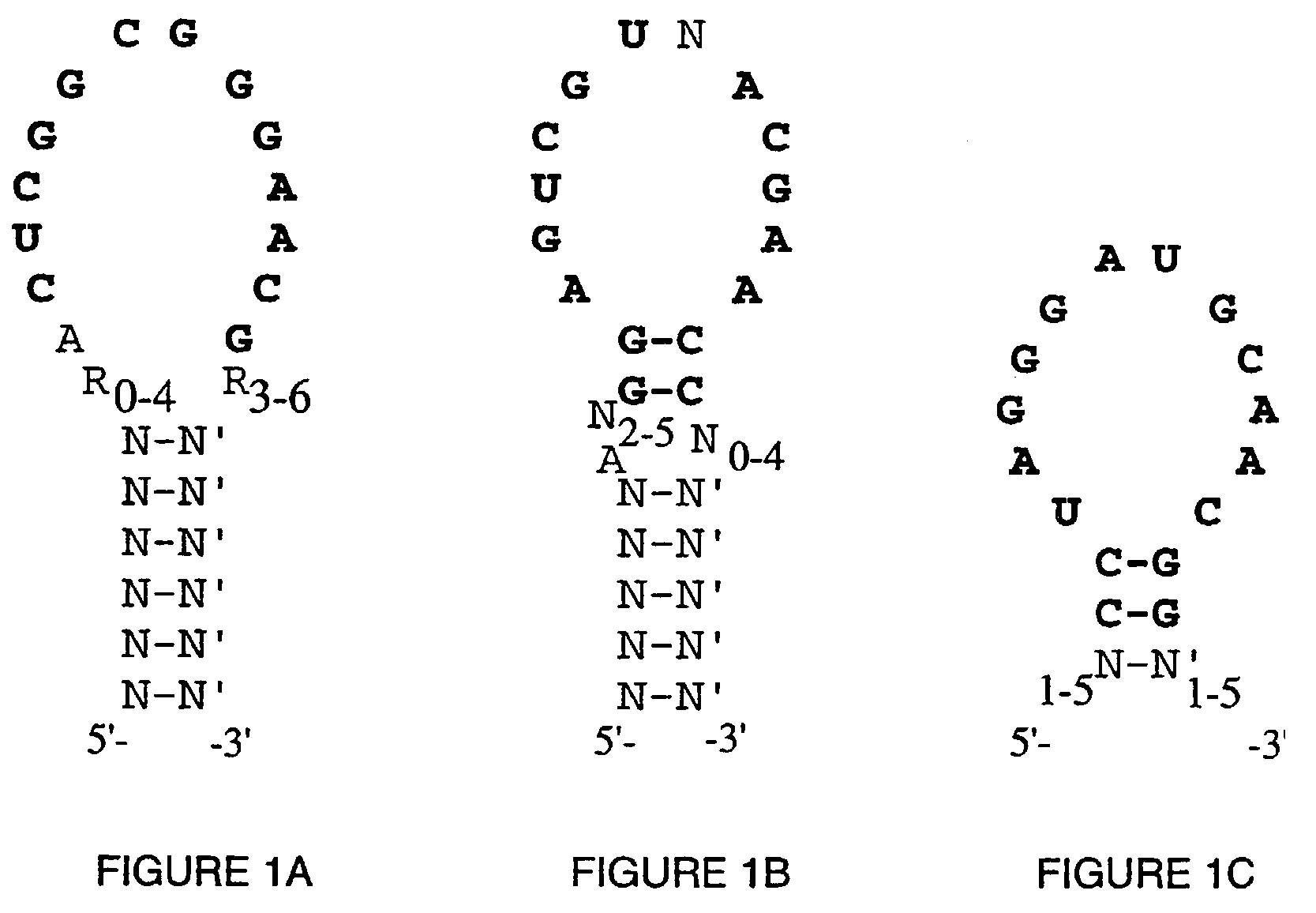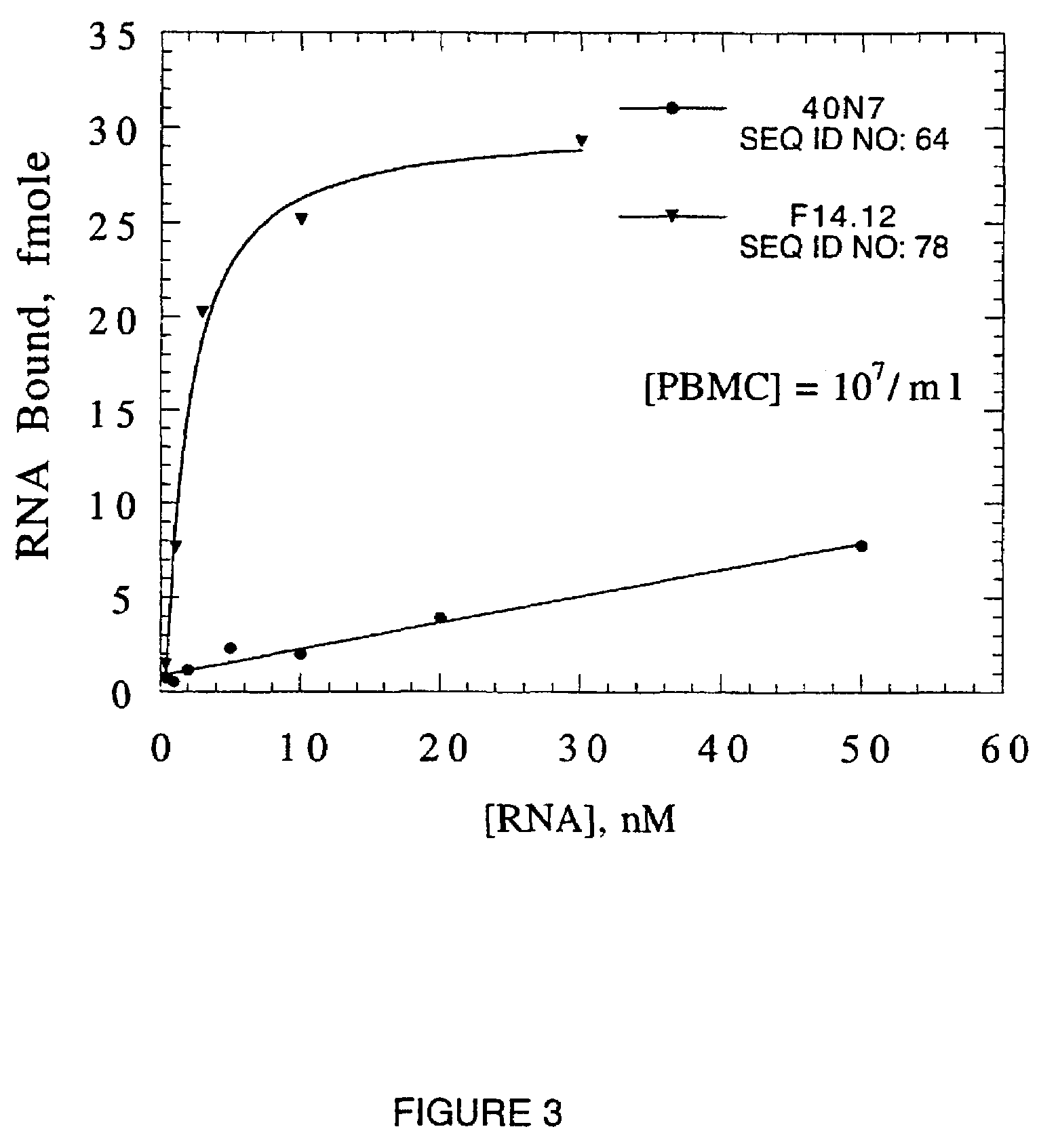High affinity nucleic acid ligands to lectins
a nucleic acid ligand, high affinity technology, applied in the field of high affinity nucleic acid ligands to lectins, can solve the problems of low affinity of lectins for mono- and oligo-saccharides, many others is poorly understood or not understood, and the difficulty of developing high affinity antagonists that may be useful therapeutics, etc., to achieve the effect of higher affinity for binding
- Summary
- Abstract
- Description
- Claims
- Application Information
AI Technical Summary
Benefits of technology
Problems solved by technology
Method used
Image
Examples
example 1
Nucleic Acid Ligands to Wheat Germ Agglutinin
[0086]The experimental procedures outlined in this Example were used to identify and characterize nucleic acid ligands to wheat germ agglutinin (WGA) as described in Examples 2-6.
Experimental Procedures
A) Materials
[0087]Wheat Germ Lectin (Triticum vulgare) Sepharose 6 MB beads were purchased from Pharmacia Biotech. Wheat Germ Lectin, Wheat Germ Agglutinin, and WGA are used interchangeably herein. Free Wheat Germ Lectin (Triticum vulgare) and all other lectins were obtained from E Y Laboratories; methyl-α-D- mannopyranoside was from Calbiochem and N-acetyl-D-glucosamnine, GlcNAc, and the trisaccharide N N′N′-triacetylchitotriose, (GlcNAc)3, were purchased from Sigma Chemical Co. The 2′-NH2 modified CTP and UTP were prepared according to Pieken et. al. (1991, Science 253:314-317). DNA oligonucleotides were synthesized by Operon. All other reagents and chemicals were purchased from commercial sources. Unless otherwise indicated, experiments ...
example 2
RNA Ligands to WGA
A. SELEX
[0107]The starting RNA library for SELEX, randomized 50N9 (SEQ ID NO: 1), contained approximately 2×1015 molecules (2 mmol RNA). The SELEX protocol is outlined in Table 1. Binding of randomized RNA to WGA is undetectable at 36 μM WGA monomer. The dissociation constant of this interaction is estimated to be >4 mM.
[0108]The percentage of input RNA eluted by (GlcNAc)3 increased from 0.05% in the first round, to 28.5% in round 5 (Table 1). The bulk Kd of round 5 RNA was 600 nM (Table 1). Since an additional increase in specifically eluted RNA was not observed in round 6a (Table 1), round 6 was repeated (Table 1, round 6b) with two modifications to increase the stringency of selection: the volume of gel, and hence the mass of WGA, was reduced ten fold; and RNA was specifically eluted with increasing concentrations of (GlcNAc)3, in stepwise fashion, with only the last eluted RNA processed for the following round. The percentage of specifically eluted RNA increase...
example 3
Specificity of RNA Ligands to WGA
[0119]The affinity of WGA ligands 6.8, 11.20 and 11.24 (SEQ ID NOS: 13, 40, and 19) for GlcNAc binding lectins from Ulex europaeus, Datura stramonium and Canavalia ensiformis were determined by nitrocellulose partitioning. The results of this determination are shown in Table 4. The ligands are highly specific for WGA. For example, the affinity of ligand 11.20 for WGA is 1,500, 8,000 and >15,000 fold greater than it is for the U. europaeus, D. stramonium and C. ensifornis lectins, respectively. The 8,000 fold difference in affinity for ligand 11.20 exhibited by T. vulgare and D. stramonium compares to a 3 to 10 fold difference in their affinity for oligomers of GlcNAc and validates the proposition that competitive elution allows selection of oligonucleotide ligands with much greater specificity than monomeric and oligomeric saccharides (J. F. Crowley et al., 1984, Arch. Biochem. and Biophys. 231:524-533; Y. Nagata and M. Burger, 1974, supra; J-P. Priv...
PUM
| Property | Measurement | Unit |
|---|---|---|
| dissociation constants | aaaaa | aaaaa |
| pH | aaaaa | aaaaa |
| density | aaaaa | aaaaa |
Abstract
Description
Claims
Application Information
 Login to View More
Login to View More - R&D
- Intellectual Property
- Life Sciences
- Materials
- Tech Scout
- Unparalleled Data Quality
- Higher Quality Content
- 60% Fewer Hallucinations
Browse by: Latest US Patents, China's latest patents, Technical Efficacy Thesaurus, Application Domain, Technology Topic, Popular Technical Reports.
© 2025 PatSnap. All rights reserved.Legal|Privacy policy|Modern Slavery Act Transparency Statement|Sitemap|About US| Contact US: help@patsnap.com



